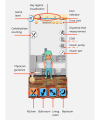A Serious Game (MyDiabetic) to Support Children's Education in Type 1 Diabetes Mellitus: Iterative Participatory Co-Design and Feasibility Study
- PMID: 38713496
- PMCID: PMC11109855
- DOI: 10.2196/49478
A Serious Game (MyDiabetic) to Support Children's Education in Type 1 Diabetes Mellitus: Iterative Participatory Co-Design and Feasibility Study
Abstract
Background: Serious games, which are gaming applications used for purposes beyond entertainment to educate users on, and address, specific issues, may present a timely approach to promote healthy diabetes management behaviors among children with type 1 diabetes mellitus (T1DM). The lasting benefits associated with these serious games encompass improved patient education; enhanced glycemic control; the reinforcement of bonds within the community of people with diabetes; the facilitation of meaningful dialogues with caregivers, especially within the familial setting; and a significant reduction in the economic burdens associated with subsequent complications.
Objective: This paper primarily aims to provide a detailed overview of the iterative design process and the associated evaluation methods used in the development of the educational game. Furthermore, this study aims to enhance motivation for sustained and extended engagement with the game over time. The MyDiabetic game design aims to educate children on various aspects, including the connections among food, insulin, and physical activity. Furthermore, it seeks to impart knowledge related to the operation of a glucometer and an insulin pen, as well as more advanced technologies such as administering glucagon, measuring ketoacidosis, and continuous glucose monitoring.
Methods: The co-design methodology was applied, involving interviews, design workshops, and prototype feedback sessions. A combination of several approaches, such as tailoring, observational learning, social and family support, decision-making practice, and reward systems, was used to support children's compliance. Moreover, incorporating the literature, guidelines, and current practices into the design ensured that the game was aligned with established health care pathways and included relevant information and best practices for diabetes management.
Results: The game was tested on 32 children in 3 iterations. Positive responses were received from children who tested the game as well as their parents. The game was also presented to 5 schoolmates of children with T1DM who appreciated a better understanding of the disease and the opportunity to support their friends more efficiently in T1DM compensation. The involvement of children and clinicians in participatory co-design contributed to to the game's high acceptance. With regard to the game's impact on education, 1 week of testing revealed an enhancement in educational outcomes.
Conclusions: The game is especially suitable for children newly diagnosed with T1DM because it acquaints them in a fun way with new terminology; for example, they can try to measure glycemia levels in an interactive way. The game also caters to children who still need to develop reading skills by including an audio guide. The guide ensures that children of all literacy levels can benefit from the game's educational content and interactive experiences. The game is available for download on Google Play and the Apple App Store.
Keywords: child; child with diabetes; children; co-design; diabetes; diabetes mellitus; gaming; glucometer; glucose; insulin; mobile app; mobile phone; patient education; serious game; serious games; user-centered design.
©Daniel Novak. Originally published in JMIR Serious Games (https://games.jmir.org), 07.05.2024.
Conflict of interest statement
Conflicts of Interest: None declared.
Figures






References
-
- Chiang JL, Maahs DM, Garvey KC, Hood KK, Laffel LM, Weinzimer SA, Wolfsdorf JI, Schatz D. Type 1 diabetes in children and adolescents: a position statement by the American Diabetes Association. Diabetes Care. 2018 Sep 09;41(9):2026–44. doi: 10.2337/dci18-0023. https://europepmc.org/abstract/MED/30093549 dci18-0023 - DOI - PMC - PubMed
-
- Bayram S, Kızıltan G, Akın O. Effect of adherence to carbohydrate counting on metabolic control in children and adolescents with type 1 diabetes mellitus. Ann Pediatr Endocrinol Metab. 2020 Sep;25(3):156–62. doi: 10.6065/apem.1938192.096. https://europepmc.org/abstract/MED/32871653 apem.1938192.096 - DOI - PMC - PubMed
-
- Lyons SK, Ebekozien O, Garrity A, Buckingham D, Odugbesan O, Thomas S, Rioles N, Gallagher K, Sonabend RY, Lorincz I, Alonso GT, Kamboj MK, Lee JM. Increasing insulin pump use among 12- to 26-year-olds with type 1 diabetes: results from the T1D exchange quality improvement collaborative. Clin Diabetes. 2021 Jul;39(3):272–7. doi: 10.2337/cd21-0027. https://europepmc.org/abstract/MED/34421202 cd210027 - DOI - PMC - PubMed
-
- Cafazzo JA, Casselman M, Hamming N, Katzman DK, Palmert MR. Design of an mHealth app for the self-management of adolescent type 1 diabetes: a pilot study. J Med Internet Res. 2012 May 08;14(3):e70. doi: 10.2196/jmir.2058. https://www.jmir.org/2012/3/e70/ v14i3e70 - DOI - PMC - PubMed
-
- Yang Q, Van Stee SK. The comparative effectiveness of mobile phone interventions in improving health outcomes: meta-analytic review. JMIR Mhealth Uhealth. 2019 Apr 03;7(4):e11244. doi: 10.2196/11244. https://mhealth.jmir.org/2019/4/e11244/ v7i4e11244 - DOI - PMC - PubMed
LinkOut - more resources
Full Text Sources

